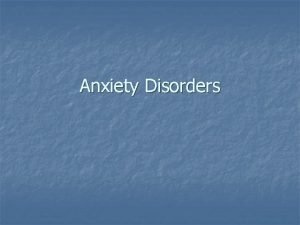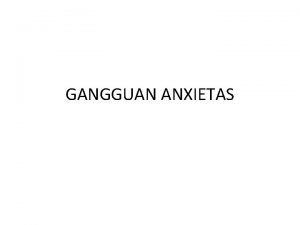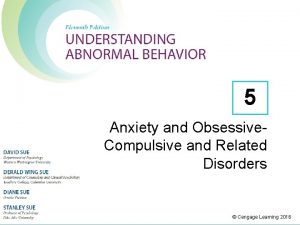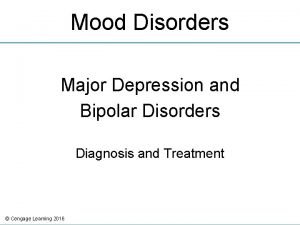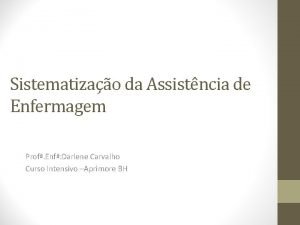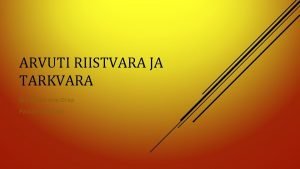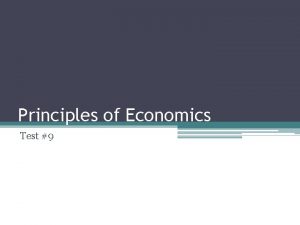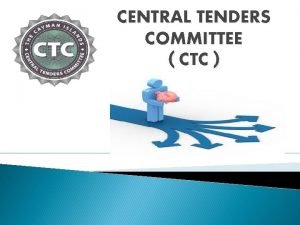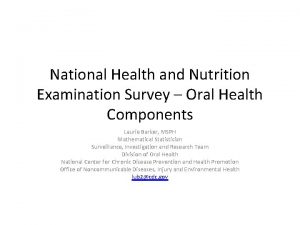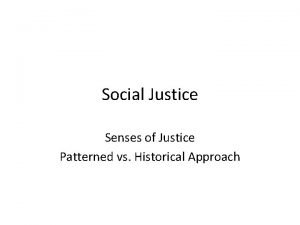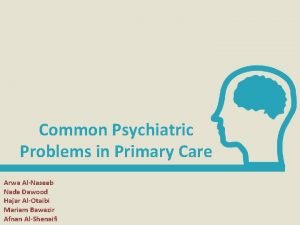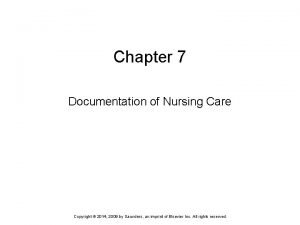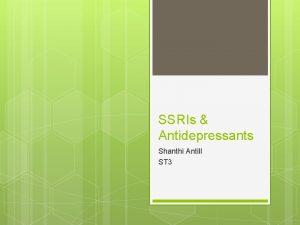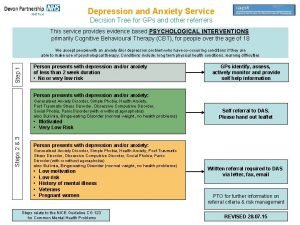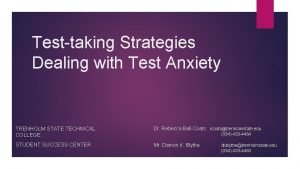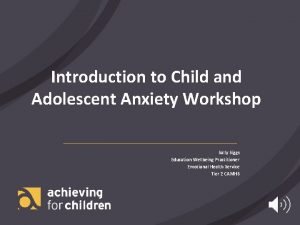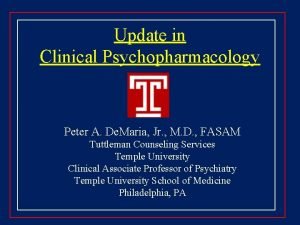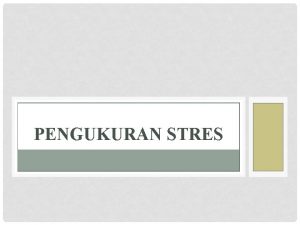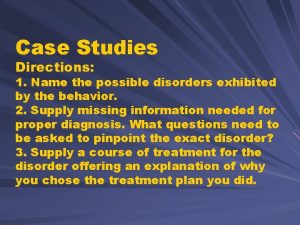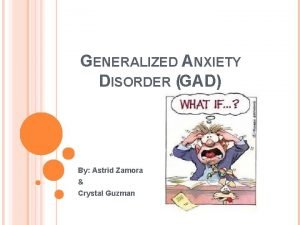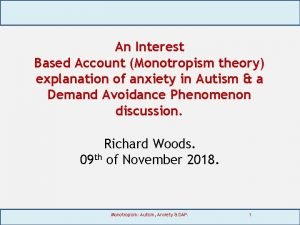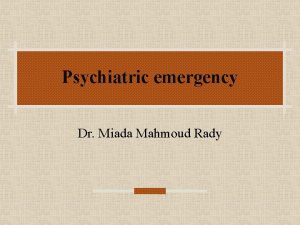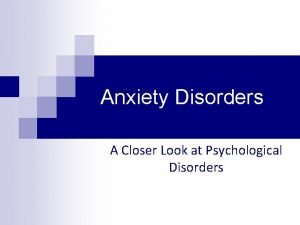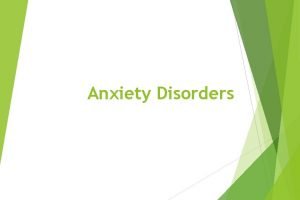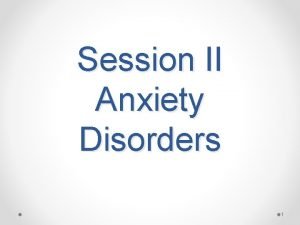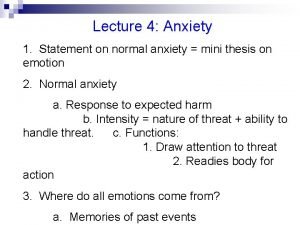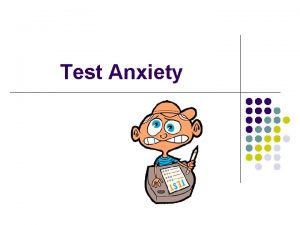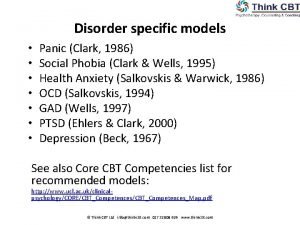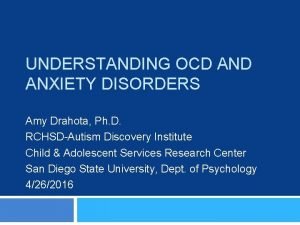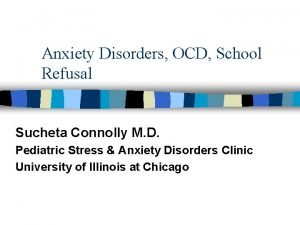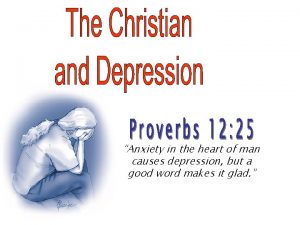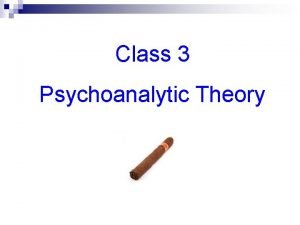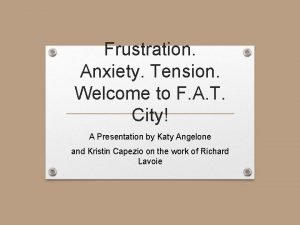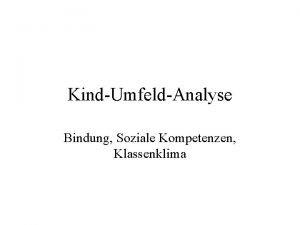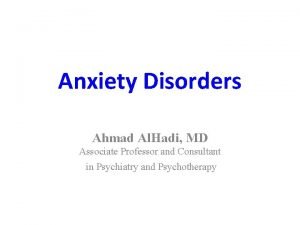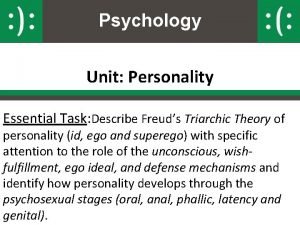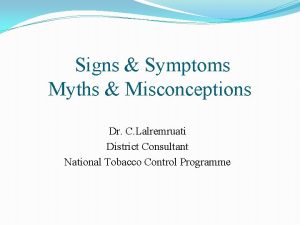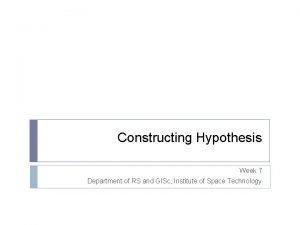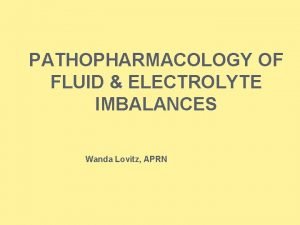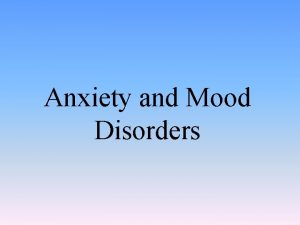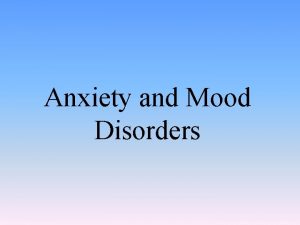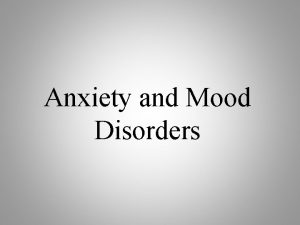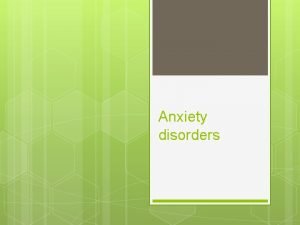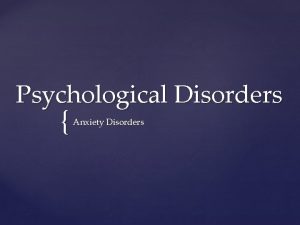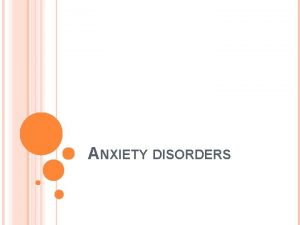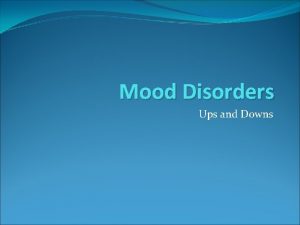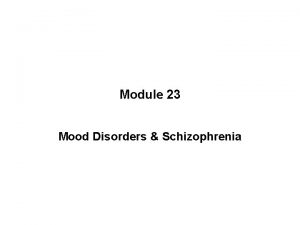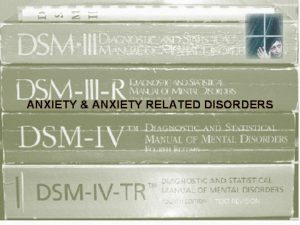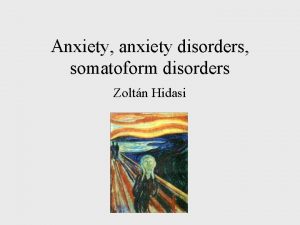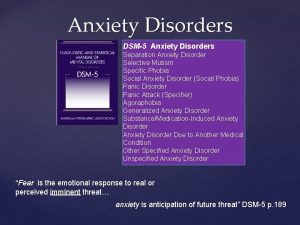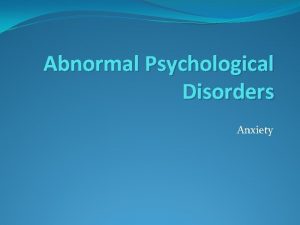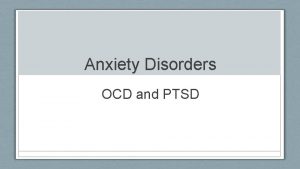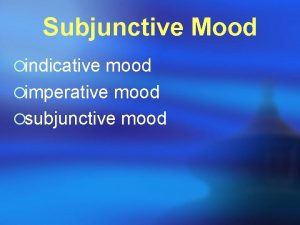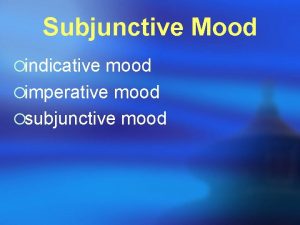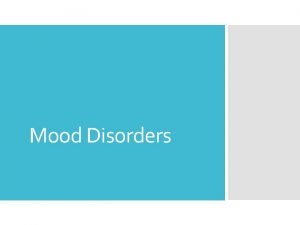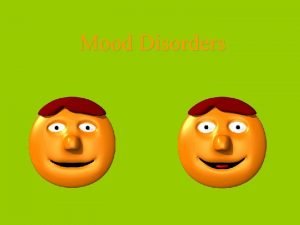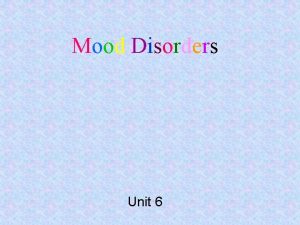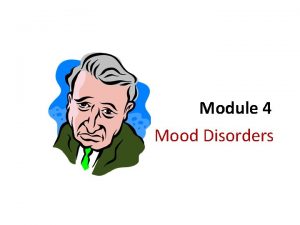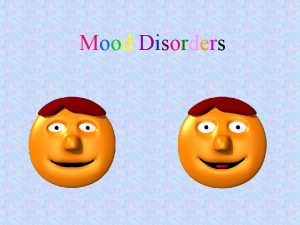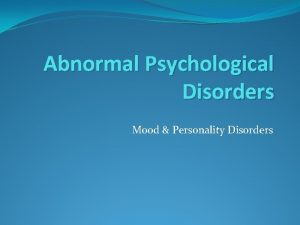PATHOPHARMACOLOGY OF THOUGHT MOOD ANXIETY DISORDERS WANDA LOVITZ





































































- Slides: 69

PATHOPHARMACOLOGY OF THOUGHT, MOOD ANXIETY DISORDERS WANDA LOVITZ, APRN

LEARNING OUTCOMES: THOUGHT, MOOD ANXIETY Upon completing this presentation, the student should be able to : Define neurotransmitter. Explain how neurotransmitters work. Identify the relationship of neurotransmitter imbalance and various mental illnesses. Describe the indications, MOA, and common and serious side effect of selected medications from the classifications of drugs used to treat thought and mood disorders: Antidepressants Barbiturates Benzodiazepines Hypnotics Antipsychotics

DRUGS TO KNOW ANTIDEPRESSAN TS ANXIOLYTICS BARBITURATES/NONBENZOS FIRST GENERATION BENZODIAZEPINES LUMINAL/PHENOBARBIT *TOFRANIL/IMIPRAMINE -TCA ELAVIL/AMITRIPTYLINE *VALIUM/DIAZEPAM - TCA NARDIL/PHENELZINE - MAOI ATIVAN/LORAZEPAM SECOND GENERATION XANAX/ALPRAZOLAM *PROZAC/FLUOXETINE -SSRI VERSED/ MIDAZOLAM ZOLOFT/SERTRALINE-SSRI LEXAPRO/ESCITAPRAM -SSRI CYMBALTA/DULOXETINE -SNRI AL – ANTISEIZURE NEMBUTAL/PENTOBAR BITAL – SEDATIVE/HYP NOTIC DALMANE/FLURAZAPAM ROMAZICON/FLUMAZENIL – SEDATIVE/HYPNOTIC - ANTIDOTE AMBIEN/ZOLPIDEM SEDATIVE/HYPNOTIC * = Prototype

DRUGS TO KNOW MOOD STABILIZERS/ MOOD STABILIZERS ANTIPSYCOTICS ANTISEIZURE LITHOBID/LITHIUM HALDOL/HALOPERIDOL DEPAKOTE/VALPROIC NEURONTIN/GABAPEN THORAZINE/CHLORPR ACID TIN – ADJUVANT TX OMAZINE TGEGRETOL/CARBAMA ZEPINE LAMITCTAL/LAMOTRIGI NE OLANZAPINE/ZYPREXA RISPERDAL/RISPERIDO NE SEROQUEL/QUETIAPIN E

NEUROTRANSMITTER • A substance released when axon terminal of PREsynaptic neuron is EXCITED • acts by INHIBITING or EXCITING a target cell • Disorders of NEUROTRANSMITTERS • Too MUCH or too LITTLE Neurological and mental illnesses • Pharmacologic treatment of mental illness derived from this basic premise

FOUR STEPS OF NEUROTRANSMITTER TRANSMISSION: 1. Synthesis of a transmitter substance 2. Storage/release of the transmitter@ PREsynapse 3. Binding of the transmitter to receptors on POSTsynaptic membrane 4. Removal of the transmitter from the synaptic cleft (Summarized in handout)

1= Synthesize 2=Storage & release @ presynapse 3=Binding @ postsynapse 4= Reuptake & Deactivation: removal and degradation 1 2 4 2 3 4 Neurotransmission

2 Deactivation of Neurotransmission: 1. Reuptake into presynaptic terminal 2. Enzymatic degradation 1 Neurotransmission

MAJOR NEUROTRANSMITTERS IMPLICATED IN MENTAL ILLNESS • Dopamine (also impt in Parkinson’s) • Norepinephrine • Serotonin (5 -HT) hydroxytryptamine • GABA gamma aminobutyric acid (Also addressed in handout)

EFFECT OF NEUROTRANSMITTERS

DEPRESSION

ANTIDEPRESSANTS • Used to treat: • • Major depression Anxiety conditions • • • GAD OCD Panic Social phobia PTSD

PHARMACOLOGICAL TREATMENT OF DEPRESSION AND ANXIETY Benzodiazipines Depression/Anxiet y Antidepressan ts

Selective Serotonin Reuptake Inhibitors Monamine Oxidase Inhbitors (SSRIs & SNRIs) Atypical Antidepressa nts (MAOIs) Tricylic Antidepressants (TCAs)

MOOD DISORDERS: PHARMACOLOGIC TREATMENT (* 2 -4 WKS) Depression First Generation ANTIDEPRESSANTS 1. (TCA) Tricyclic antidepressants 2. (MAOI) Monoamine oxidase inhibitors Second-Generation ANTIDEPRESSANTS 1. SSRI Selective Serotonin Reuptake Inhibit 2. SNRI Serotonin Norepinephrine Reuptake Inhibitors

TRICYCLIC ANTIDEPRESSANTS • MOA: • Block REUPTAKE of neurotransmitters NE and serotonin (5 -HT) • causing ↑ ACCUMULATION at nerve endings • Indications: • Depression, bipolar disorder , neuropathic pain, panic disorder, OCD, chronic pain, anxiety Adverse Effects: • Anticholinergic effects (dry mouth, constipation, blurred vision, and sedation) • Sedation/orthostatic hypotension • Sexual dysfunction • Common Drugs: • amitriptyline (Elavil) • imipramine (Tofranil)* PROTOTYPE

TRICYCLIC ANTIDEPRESSANTS (TCA) • Treat depression for over 40 years (1950’s) • ↑ efficacy • Less expensive than newer agents • Side effect profiles well established • • annoying anticholinergic effects: dry mouth, blurred vision, urine retention and hypertension SLUG • not recommended for patients with heart problems OVERDOSES → NOTORIOUSLY LETHAL • • NO ANTIDOTE! FYI: also given for neuropathic pain, fibromyalgia, and management of nocturnal enuresis

MONOAMINE OXIDASE INHIBITORS (MAOI) • SECOND-LINE AGENTS for treatment of depression NOT responsive to other pharmacologic agents – “treatment resistive depression” • Especially useful for ATYPICAL depressions • Prototype phenelzine (Nardil) • Serious disadvantage → potential for HYPERTENSIVE CRISIS when taken WITH tyramine (an amino acid)

WHAT ARE MONOAMINE OXIDASE INHIBITORS? • MOA: • INHIBIT THE ENZYME MAO • MAO widely distributed in body, particularly in nerves, liver & lung • MAO is responsible for INACTIVATING many important neurotransmitters in nervous system (particularly dopamine, epinephrine, norepinephrine & serotonin) • Inhibit MAO → then less INACTIVATION and therefore…… • ↑ NEUROTRANSMITTERS AT NERVE ENDINGS!

MONOAMINE OXIDASE INHIBITORS • Adverse Effects/Interactions • CNS stimulation – • • • anxiety, insomnia, agitation and elevated mood Weight gain, diarrhea, orthostatic hypotension and sexual dysfunction Seizures and liver toxicity Drug-food interaction • Tyramine (amino acid) + MAOI = HYPERTENSIVE CRISIS! • Tyramine displaces presynaptic NOREPINEPHRINE = ↑↑↑ BP • • ↑ BP abruptly/dramatically May cause cerebral hemorrhage, stroke, coma or death

WHAT FOODS CONTAIN TYRAMINE? • Tyramine-rich foods • Aged cheese (swiss, blue, cheddar) • Smoked meats (pepperoni, salami) • Yeast • Red wines • Italian broad beans

SELECTIVE SEROTONIN REUPTAKE INHIBITORS (SSRIS) • NEWER classification of antidepressants (1980’s) • INDICATION: FIRST LINE ANTIDEPRRESSANT AND ANTXIOLYTIC • Some SSRIs are also used for GAD, diabetic neuropathy chronic pain, OCD, PTSD, social anxiety disorder, and premenstrual dysphoric disorder • Advantages over TCAs/MAOIs: • LESS SEVERE/FEWER side effects (especially with elderly) • Few drug-drug/drug-food interactions • Takes approx 4 weeks to reach maximum clinical effectiveness!! • Should be tapered when discontinuing to avoid withdrawal sx • Serious Drug- Drug Interaction • Do not give WITH MAOIs (possibly fatal serotonin syndrome!)

SELECTIVE SEROTONIN REUPTAKE INHIBITORS Common Drugs: fluoxetine/Prozac *prototype ◦ Other commonly rx SSRIs ◦ ◦ ◦ sertraline/Zoloft citalopram/Celexa escitalapram/Lexapro ◦ MOA: inhibits serotonin reuptake

SELECTIVE SEROTONIN REUPTAKE INHIBITORS • MOA: • Specific/potent INHIBITORS of presynaptic serotonin reuptake • thus ↑ levels at nerve endings • Adverse Effects: • • • Generally well tolerated GI disturbances • N/V/D, constipation, dry mouth CNS disturbances • H/A, nervousness, insomnia Sexual dysfunction Suicidality (esp in children), seizures Serotonin Syndrome

WHAT IS SEROTONIN SYNDROME? • • A DRUG REACTION caused by body having too much serotonin accumulating in the brain stem and spinal cord • SX: altered mental status and coordination • • • Often occurs when 2 drugs that affect serotonin are taken together • • Agitation and restlessness SSRI with an MAOI Migraine meds with SSRI Hallucinations Diarrhea Diaphoresis and Fever Overactive reflexes Confusion • Treatment • • • Benzo Withdrawal of meds Drug called Periactin that blocks serotonin production

INHIBITION OF REUPTAKE OF SEROTONIN

SEROTONIN-NOREPINEPHRINE REUPTAKE INHIBITOR SNRI • Adverse Effects: • Cymbalta/duloxetine • MOA: prevents the reuptake of serotonin AND norepinephrine • Indications: • • Depression Anxiety Peripheral Neuropathy Chronic musculoskeletal pain • Similar to the SSRIs • Important to note the increased risk of SUICIDE with both SSRIs and SNRIs

SUMMARY: DRUGS TO TREAT DEPRESSION TCAs and MAOIs (older drugs with more SE) SSRIs (selective SEROTONIN reuptake inhibitors) SNRIs (Serotonin-NOREPINEPHRINE reuptake inhibitors)

ANXIETY DISORDERS

ANXIETY DISORDERS: 5 SUBTYPES ANXIETY MAY COEXIST WITH DEPRESSION, EATING DISORDERS, AND SUBSTANCE ABUSE PANIC disorder intense feelings of immediate apprehension, terror, or impending doom Post-traumatic stress disorder (PTSD) type of extreme situational anxiety that develops in response to a previous life event Generalized ANXIETY disorder excessive anxiety lasting 6 months or more very common SOCIAL ANXIETY disorder fear of crowds Obsessive-compulsive disorder (OCD) recurrent, intrusive thought or repetitive behaviors that interfere with

ANXIETY/SLEEP DISORDERS: PHARMACOLOGY Anxiolytics relieve anxiety Sedatives cause relaxation Hypnotics produce sleep Low dose – High dose = anxiolytic or hypnotic ------------- Sedatives Hypnotics Anxiolytics Anxiety Nervousness/ excitability without causing sleep Cause sleep

TWO MAJOR CLASSES OF ANXIOLYTICS: SEDATIVES/HYPN OTICS 1. BENOZODIAZEPINES 2. BARBITURATES (NON-BENZOS)

BENZODIZEPINES • Indications: • treatment of anxiety and insomnia • to augment SSRI/SNRIs • do NOT affect serotonin so no risk for Serotonin Syndrome • also used to treat: • • • seizure disorder ETOH withdrawal for central muscle relaxation (muscle • Commonly rx benzos: • For insomnia: • flurazepam/Dalmane • For anxiety: • • diazepam/Valium lorazepam/Ativan alprazolam/Xanax midazolam/Versed • also used to induce anesthesia

BENZODIAZEPINES • Most given orally and IV • MOA: • Bind to gammaaminobutyric acid (GABA) receptor • Intensify the effect • • diazepam/Valium lorazepam/Ativan midazolam/Versed (IV only) Advantage of Benzos over Barbiturates: • of GABA • GABA is a natural INHIBITORY neurotransmitter found in the brain • they do not produce lifethreatening resp depression or coma (if taken in excessive amounts) MUCH SAFER THAN BARBITURATES • antidote is available for overdoses: • flumazenil/ Romazicon

BENZODIAZEPINES/BENZO LIKE DRUGS • Benzodiazepines work by enhancing response to GABA • Onset of action is IMMEDIATE • Main SE are sedation, psychomotor slowing, and amnesia • Physical dependence can occur with long term use – Schedule IV drugs • Benzodiazepines can be classified as EITHER • • SEDATIVE/HYPNOTICS ANXIOLYTICS Anxiolytics Sedatives/ Hypnotics Benzodiazepines

COMMON BENZODIAZEPINES/ANXIOLYTICS Valium/ *Ativan/ diazepam lorazepam Benzos/Anxiolytics rapid relief of anxiety Xanax/ alpraxolam Versed/ midazolam – given to induce anesthesia

EXAMPLES OF BENZO/BENZO-LIKE AGENTS Anxiolytics Sedative/Hypnoti cs *Ativan/lorazepam *Ambien/zolpidem Valium/diazepam Dalmane/flurazapa m newer agent/less SE Romazicon/flumazenil is the ANTIDOTE for all of the benzodiapine and benzo like drugs

Benzos/nonbenzos INDICATIONS: BENZOS AND NON-BENZOS Decrease anxiety –First line tx for anxiety To promote drowsiness and relaxation prior to procedures Inhibit seizure activity Promote sleep Induce anesthesia

BARBITURATES • Barbiturates (also known as “nonbenzos”) are drugs derived from barbituric acid • Cause very powerful CNS depression • Prescribed for: • • SEDATIVE EFECT HYPNOTIC EFFECT • ANTI-SEIZURE EFFECT- most common indication • Not commonly prescribed today for sedation because of: • High risk of psychological and physical dependence. . several are Schedule II drugs • WITHDRAWAL FROM THESE DRUGS CAN BE SEVERE AND EVEN FATAL! • Overdose causes profound resp depression, hypotension and shock

BARBITURATES FOR SLEEP: HYPNOTICS • Rarely used today d/t habit forming nature of this class of drugs - tolerance/dependence • Examples of barbiturates: • pentobarbital/Nembutal – sedative • phenobarbital/ Luminal – anti-seizure

OTHER AGENTS USED FOR ANXIETY AND INSOMNIA • propranolol/Inderal – a beta • zolpidem/Ambien for insomnia blocker used for social anxiety • symptoms including ‘test anxiety’ Ambien NOT chemically r/t benzos but does interact with GABA receptors • Considered a “non-benzo” • Ambien generally preserves all sleep stages with little effect on REM sleep • Should only be used for shortterm tx of insomnia (7 -10 days)

MOOD DISORDERS

MOOD DISORDERS • MAJOR (unipolar) DEPRESSION • MOST COMMON MOOD DISORDER • • • 8 -20% of population Unable to experience pleasure Show loss of outside interest • Bipolar disorder (Manic-depression) • • • Recurrent patterns of depression & mania • cyclic episodes of energized mania and deep depression • episodes can last months or even years Bipolar is less common than unipolar Usually emerges in young adulthood

MANIA DIAGNOSIS • • • Genetic component Manic episode of at least one weeks duration that leads to hospitalization or other significant impairment Grandiosity • Diminished need to sleep • Excessive talking or pressured speech • Increased level of goal focused activities

PATHOPHYSIOLOGY OF BIPOLAR DISORDER • NOT ENTIRELY KNOWN • Genetic, neurochemical and environmental factors • Current thinking: a predominantly biological disorder d/t malfunction of neurotransmitters • Malfunctioning neurotransmitters: Serotonin, dopamaine and norepinephrine • May lie dormant and be activated spontaneously or triggered by stressors in life Mania episodes – high levels of norepinephrine cause an exhilarating high, euphoric, hypersexual, spending sprees, aggressive Depressive episodes – low levels of serotonin cause the person to experience a plummeting fall from the euphoric manic stage, sad, unable to cope Psychotic Symptoms – too much dopamine affects emotions and perceptions is linked to psychotic sx such as hallucinations

PATHO OF MANIA • Poorly understood • Imaging studies show changes in brain structure • Seem to be associated with imbalance in neurotransmitters • Diagnosis: • Manic sx must be present for at least one week

DRUGS TO TREAT MANIA • Mood Stabilizers *Lithium *Valproic acid • Relieve sx during manic and depressive episodes • Anti-seizure • Antidepressants SSRIs • With Bipolar, antidepressants ALWAYS combined with a mood stabilizer to avoid elevating the mood so much that a manic episode may be triggered • Antipsychotics and/or benzodiazepines Risperdal • Given to help control severe manic episodes • Ativan alone may be enough.

DRUGS FOR MANIA: MOOD STABILIZERS • Mania “mood stabilizers” • Lithium salts • as monotherapy or in combination with other drugs • Atypical Antipsychotics • • • olanzapine/Zyprexa risperdal/Risperdal* quetiapine/Seroquel • Antiseizure drugs • • • sometimes used to tx mood disorders valproic acid/Depakote carbamazepine/Tegretol lamotrigine/Lamictal

TREATING MANIA LITHIUM (1970) • Norepinephrine & serotonin play role in development of mania • • - MOOD STABILIZERS: ( NE & serotonin = mania) Lithium • Mainstay treatment of bipolar disorder (mania) • • MOA: How Lithium works is still not fully understood More effective in controlling mania than depression Alters SODIUM ion transport in nerve cells → • ↓ NE & 5 HT (serotonin) metabolism and synthesis • SE: common = dazed feeling and hand tremors • polyuria (up to 3 Liters a day), excessive thirst • • Imbalance in ELECTROLYTES Acts like sodium in the body • Inhibits ADH and ability for body to concentrate urine

TREATING MANIA: {LITHIUM} • MOOD STABILIZERS Lithium • NOT metabolized in liver • • 98% excreted unchanged in kidney NARROW THERAPEUTIC INDEX: • 0. 5 – 1. 5 meq/dl • Monitor serum levels q 1 – 3 days initially • • also monitor sodium levels • Monitor q 2 – 3 months thereafter • Dehydration/excessive sweating can increase lithium toxicity Requires one week of treatment before see results

TREATING MANIA: LITHIUM MOOD STABILIZERS • Lithium - adverse effect: • ‘Lithium toxicity’ • Diarrhea** (classic early symptom) • • • Tremors (fine or gross) 1. 5 – 2 m. Eq/L Slurred speech Drowsiness/somnolence 2 – 2. 5 m. Eq/L Seizures Cardiac dysrhythmias • Death > 2. 5 m. Eq/L

DEPAKOTE/VALPROIC ACID: MOOD STABLIZER • First line treatment for bipolar manic episodes • Is an anti-seizure med • Works faster and less SE than Lithium • Known teratogen • Side Effects: • Well tolerated generally but CAN cause • • WEIGHT GAIN - frequent Thrombocytopenia - rare Pancreatitis -rare Liver Failure- rare

THOUGHT DISORDERS (PSYCHOSIS)

SCHIZOPHRENIA • 1% of world population • 30% homeless have schizophrenia • Thought disorder that involves a loss of touch with reality delusions, grandiose delusions, paranoid delusions, mood disturbances, behavior disturbances, purposeless aimless mannerisms, disorganized speech • Strong genetic predisposition • Onset typically occurs between 20 & 35 years of age

SCHIZOPHRENIA: PATHOGENESIS • Not sure, several theories • Neurotransmitter alteration theory • DOPAMINE HYPOTHESIS of schizophrenia • Abnormal ↑ in dopaminergic transmission contributes to the onset of schizophrenia

SCHIZOPHRENIA: A TYPE OF PSYCHOSIS • NEGATIVE SYMPTOMS ◦ SUBTRACT from the normal behavior ◦ ◦ lack of motivation/interest/drive indifferent personality Poor self care, judgement • POSITIVE SYMPTOMS • ADD on the normal behavior • • • Flattened affect ◦ **sometimes mistaken for depression or laziness • • hallucinations delusions disorganized thoughts or speech patterns Combativeness “VOICES”

SCHIZOPHRENIA: PHARMACOLOGIC TREATMENT • Antipsychotics • • sometimes referred to as ‘neuroleptics’ because of the NEUROLOGICAL side effects 1. Typical • • Conventional, first-generation agents (FGA) • Less effective for negative sx Help with controlling the positive sx – auditory and visual hallucinations and delusions – emotional and social withdrawal and blunted affect 2. Atypical • • • Second-generation agents (SGA) Effective for both positive and negative symptoms Can be used to tx acute mania and bipolar depression

ANTI-PSYHCOTICS: SE Thorazine Haldol chlorpramazine Haloperidol Low EPS Low potency FGA Very High EPS High potency FGA Risperdal risperidone Zyprexa Mod EPS Low EPS SGA olanzapine

ANTIPSYCHOTICS • Mechanism of Action • Indications • Schizophrenia • Bipolar • OCD • Severe depression • Typicals – block D 2 receptor (dopamine) • Common extrapyramidal SE • Atypicals – block D 2 AND 5 HT (dopamine and serontonin) • produce fewer extrapyramidal SE because they are loosely bound to D 2 receptors • Weight gain, DM, and dyslipidemia common

ANTIPSYCHOTICS • Conventional/Typical Antipsychotic • chlorpromazine/Thorazine • haloperidol/Haldol* • Atypical Antipsychotics • olanzapine/Zyprexa • risperidone/Risperd al • quetiapine/Seroquel

ANTIPSYCHOTICS: MOA • All antipsychotics have a COMMON MOA • Block dopamine receptors in the brain • thus ↓ dopamine concentration in CNS • Atypical antipsychotics block specific DOPAMINE receptors • as well as specific SEROTONIN receptors in the brain (5 HT)

SIDE EFFECTS OF ANTIPSYCHOTICS ANTICHOLINERGI C METABOLIC EXTRAPYRAMIDA L SYMPTOMS (EPS) MOVEMENT DISORDERS ACUTE DYSTONIA- dry mouth WEIGHT GAIN blurred vision DYSLIPIDEMIA photophobia HEART DISEASE urinary retention DIABETES constipation tachycardia * SEEN MORE WITH THE NEWER ANTIPSYCHOITCS SEVERE SPASMS OF NECK, TONGUE, FACE, OR BACK – OCCURS EARLY IN TX (HOURS/DAYS) PARKINSONISM BRADYKINESIA, MASK-LIKE FACIES, DROOLING, TREMOR RIGIDITY, SHUFFLING GAIT, STOPPED POSTURE, COGWHEELING – OCCURS EARLY IN T AKATHSIA UNCONTROLLABLE URGE TO BE IN MOTION (PACING AND SQUIRMING) – OCCURS EARLY IN TX TARDIVE DYSKINESIA MOST TROUBLING SE- OCCURS LATE IN THERAPY OCCURS IN 15 -20% OF PTS THOUGHT TO BE R/T OVER

NEUROLOGICAL SIDE EFFECTS OF ANTIPSYCHOTICS Acute Akathisa Dystonia Parkinsonis m Tardive Late/chronic Tardive Dyskinesia “Chronic” Perioral Movements

AKATHISIA • Means “inability to sit still” • Subjective distress • Akathisia can be confused with agitation • Frequently occurs 5 -30 days after therapy begins • Can occur with not only FGA but also with • the 2 nd generation atypicals

ACUTE DYSTONIA • Intermittent and sustained contractions of muscles of the tongue, face, neck and back • Typically occurs during the first 5 -30 days of treatment • Responds rapidly to anti-parkinsonism agents and Botox

PARKINSONSIM • Antipsychotics can induce symptoms similar to parkinson’s disease • Generally happens 5 -30 days after starting tx • • tremor muscle rigidity stooped posture shuffling gait

TARDIVE DYSKINESIA Tardive dyskinesia (TD) Involuntary contractions of oral and face muscles choreoathetosis (wave-like movements of extremities) Starts as slow, worm-like movements of the tongue Can interfere with chewing, swallowing, speaking Malnutrition and weight loss can occur Over time involuntary movements of the limbs, toes, fingers, and trunk occur

SUMMARY SE OF ANTIPSYCHOTICS Conventional/ Typical (FGA) Atypical Drugs haloperidol/Haldol chlorpromazine/Thorazine quetipaine/Seroquel aripiprazole/Abilify olanzapine/Zyprexa Common Side Effects Extrapyramidal Weight gain Anticholinergic effects Type 2 DM Anti-cholinergic SE (dry mouth, blurred vision, photophobia, urinary retention/hesitancy, tachycardia) (SGA) Cardiac Disease Sedation

 Anxiety disorders def
Anxiety disorders def Icd 10 anxietas
Icd 10 anxietas Multipath model of anxiety disorders
Multipath model of anxiety disorders Chapter 15 anxiety and obsessive-compulsive disorders
Chapter 15 anxiety and obsessive-compulsive disorders Dsm 5 mood disorder
Dsm 5 mood disorder Complete and incomplete thinking
Complete and incomplete thinking Wanda horta
Wanda horta Wanda jochemczyk
Wanda jochemczyk Wanda andreoni
Wanda andreoni Wanda-helene
Wanda-helene Poppy2014
Poppy2014 Przesiedlenie z niemiec do polski a emerytura
Przesiedlenie z niemiec do polski a emerytura Yadier molina wife
Yadier molina wife How much does wanda earn per hour
How much does wanda earn per hour Wanda ebanks
Wanda ebanks Kecap sulur nyaeta
Kecap sulur nyaeta Caching gatra ing tembang sinom ana
Caching gatra ing tembang sinom ana Wanda jean allen
Wanda jean allen Wanda ochei
Wanda ochei Iousa worksheet
Iousa worksheet Maria wanda
Maria wanda Wanda orlikowski
Wanda orlikowski Dr wanda hu
Dr wanda hu Juan de fuca ridge
Juan de fuca ridge How much did wanda pay in taxes this pay period
How much did wanda pay in taxes this pay period Dr wanda burger
Dr wanda burger Wanda cordaway
Wanda cordaway Wanda patronka
Wanda patronka Wanda pezzi
Wanda pezzi Generalized anxiety disorder dsm 5
Generalized anxiety disorder dsm 5 Pie nursing note example
Pie nursing note example Severe anxiety
Severe anxiety Chapter 8 managing stress and anxiety
Chapter 8 managing stress and anxiety Anxiety decision tree
Anxiety decision tree Relaxation techniques test anxiety
Relaxation techniques test anxiety Anxiety explanation
Anxiety explanation Snri social anxiety
Snri social anxiety Stai adalah
Stai adalah Levels of anxiety nursing
Levels of anxiety nursing Teenagers anxiety friend
Teenagers anxiety friend Sadie is so fearful of being overwhelmed by anxiety
Sadie is so fearful of being overwhelmed by anxiety Hamilton anxiety rating scale
Hamilton anxiety rating scale Astrid zamora
Astrid zamora Anxiety explanation
Anxiety explanation Stress anxiety depression
Stress anxiety depression Define neurotic
Define neurotic Explanation of anxiety disorder
Explanation of anxiety disorder Apprehension vs anxiety
Apprehension vs anxiety What is anxiety examples
What is anxiety examples Test anxiety essay
Test anxiety essay Cpi supportive stance reasons
Cpi supportive stance reasons Neurotic anxiety example
Neurotic anxiety example Anxiety symptoms
Anxiety symptoms The vicious flower cognitive model of ocd
The vicious flower cognitive model of ocd Explanation of anxiety disorder
Explanation of anxiety disorder Status anxiety
Status anxiety Sucheta connolly md
Sucheta connolly md Anxiety in the heart of man causes depression
Anxiety in the heart of man causes depression Neurotic symptoms
Neurotic symptoms Tips anxiety
Tips anxiety Frustration anxiety and tension
Frustration anxiety and tension Alfred adler was a neo-freudian who coined the term
Alfred adler was a neo-freudian who coined the term Separation anxiety test
Separation anxiety test Anxiety goals for nursing care plan
Anxiety goals for nursing care plan Prayer for success in exams
Prayer for success in exams Agoraphobia vs social phobia
Agoraphobia vs social phobia Castration anxiety
Castration anxiety Heart attack lan chhuah dan
Heart attack lan chhuah dan Chapter 18 managing anxiety
Chapter 18 managing anxiety Directional hypothesis example
Directional hypothesis example
